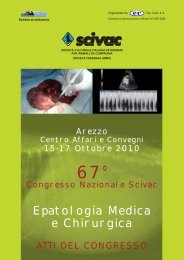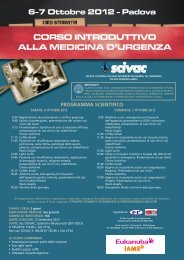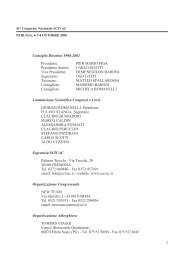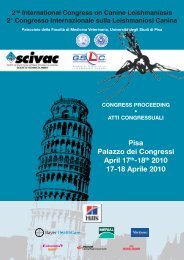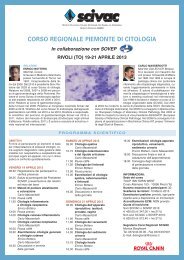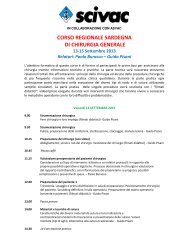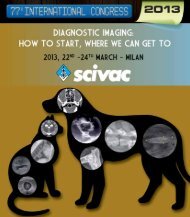58° Congresso Nazionale SCIVAC: Oncologia veterinaria
58° Congresso Nazionale SCIVAC: Oncologia veterinaria
58° Congresso Nazionale SCIVAC: Oncologia veterinaria
Create successful ePaper yourself
Turn your PDF publications into a flip-book with our unique Google optimized e-Paper software.
58° <strong>Congresso</strong> <strong>Nazionale</strong> <strong>SCIVAC</strong> • Milano, 7-9 Marzo 2008 • <strong>Oncologia</strong> <strong>veterinaria</strong> - Alle soglie del III Millennio<br />
are dependent on DNA/cellular proliferation but are not cell cycle specific.<br />
Toxicity is usually expressed when the cell enters the S-phase and is unable<br />
to replicate.<br />
Pharmacokinetics<br />
Cyclophosphamide can be administered orally (PO) or intravenously (IV).<br />
The oral administration route shows variable bioavailability ranging from 74-<br />
97%. Following IV administration maximal plasma concentration is achieved<br />
in 2-3 hours. Cyclophosphamide is widely distributed into body tissues. In veterinary<br />
medicine the recommended dosage for cyclophosphamide is 50<br />
mg/m 2 PO four days per week or a single dose of 250 mg/ m 2 every 3 weeks.<br />
Injectable cyclophosphamide is administered at doses ranging from 100-300<br />
mg/m 2 IV as often as once weekly, depending on the protocol involved.<br />
Cyclophosphamide is a prodrug that is activated by cytochrome p450 enzymes<br />
in the liver. The active 4-hydroxycyclophosphamide is rapidly metabolized<br />
to inactive 4-ketocyclophosphamide and carboxyphosphamide metabolites.<br />
Aldophosphamide spontaneously converts to phosphoramide mustard and<br />
acrolein. Phosphoramide mustard is the active anticancer agent. Acrolein is<br />
primarily responsible for the hemorrhagic cystitis complication. The main elimination<br />
route of cyclophosphamide and its metabolites is by renal excretion.<br />
Approximately 36-99% of the conventional dose is excreted in the urine within<br />
48 hours with about 5-30% being unchanged drug. Less than 4% of the<br />
dose is recovered in feces.<br />
Toxicity<br />
Dose limiting toxicity is myelosuppression with a nadir of 7-14 days, gastrointestinal<br />
side effects, a transient increase in liver enzymes, sterile hemorrhagic<br />
cystitis, anorexia, nausea, vomiting, alopecia in susceptible breeds, and<br />
infertility. Myelosuppression is exacerbated by other drugs in common chemotherapy<br />
combination protocols.<br />
Indications<br />
Cyclophosphamide is used widely in veterinary medicine for treatment of<br />
lymphomas, leukemias, carcinomas and sarcomas in dogs and cats, mainly in<br />
combination protocols. Cyclophosphamide may be prescribed for treatment<br />
autoimmune diseases in veterinary medicine.<br />
58



